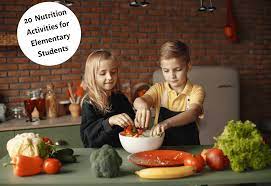Teaching children about nutrition and healthy eating habits is essential for their growth and well-being. Here are 20 engaging and educational nutrition activities for elementary students to help them learn the importance of maintaining a balanced diet.
1. Food Group Sorting: Cut out pictures of various food items and have students sort them into the appropriate food groups (i.e., proteins, grains, fruits, vegetables, and dairy).
2. Colorful Plate: Encourage students to draw a colorful plate using all the different food groups and emphasizing the importance of variety in a balanced diet.
3. Grocery Shopping Field Trip: Visit a local grocery store for hands-on lessons about choosing healthy foods.
4. Collaborative Cookbook: Assign each student a healthy dish to research, prepare, and share with the class in a group cookbook.
5. Taste Test Challenge: Expose students to new healthy foods by hosting a taste test session in which they sample an array of fruits, vegetables, and unique dishes.
6. Food Group Bingo: Create customized bingo cards featuring images or names of various foods from each food group.
7. Plant a Classroom Garden: Teach children about the growth process of fruits and vegetables by planting seeds and tending to their classroom garden.
8. Guess That Nutrient: Hold a trivia-style game where students take turns guessing which nutrients (fiber, protein, vitamins) are present in common food items.
9. Build-Your-Own Salad Bar: Provide students with an assortment of vegetables, proteins, grains, and dressings to create their salads while emphasizing portion control and balance.
10. Smoothie Science: Demonstrate how to make nutrient-rich smoothies using fruits, vegetables, yogurt, milk, or alternative milk sources.
11. Reading Nutrition Labels: Teach students how to read nutrition labels on packaged foods and analyze their nutritional content.
12. Healthy Snack Prep: Discuss healthy snack options for when kids are on the go or at home and have them prepare a healthy snack to share with the class.
13. Nutrition Newsletters: Assign students to write a short article about a specific food, nutrient, or health-related topic and compile them into a classroom nutrition newsletter.
14. Poster Presentations: Encourage students to create posters highlighting nutritional facts and benefits of their favorite fruits, vegetables, or other nutritious foods.
15. Analyzing Advertisements: Work together with your students to critique food advertisements and search for accurate information about the nutritional benefits of various products.
16. Snack Attack!: Divide class into teams; each team has to prepare a healthy snack using pre-determined ingredients while learning about portion sizes and nutritional content.
17. Role-Playing Exercise: Have students perform skits or role-plays showcasing different scenarios related to healthy eating choices and peer pressure at school or social events.
18. MyPlate Models: Using paper plates or other materials, let students model their ideal meal based on MyPlate recommendations for a balanced diet.
19. Nutrition Experts: Invite guest speakers such as nutritionists, dietitians, or personal trainers to talk with your class about the importance of healthy eating and share tips for making nutritious choices.
20. Charting Progress: Help students track their healthy eating progress using goal-setting charts where they can monitor their consumption of fruits, vegetables, protein, dairy, and grains on a weekly basis.
By incorporating these 20 nutrition activities into your elementary classroom curriculum, you can help cultivate a generation of health-conscious individuals who understand the importance of making informed choices when it comes to their diets.





